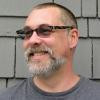
John Slepian

John Slepian, Five College associate professor of art and technology, received a B.F.A. in film and television from New York University and an M.F.A. in new genres from the San Francisco Art Institute.
His interactive installations, which feature projected and screen-based 3D computer animation, investigate what makes us feel engaged with other living beings. Slepian's artwork has been shown at the Exploratorium and Catharine Clark Gallery in San Francisco, the Art Gallery at Siggraph06 in Boston, and P.S.1/MoMA and Hunter College Art Galleries in New York. In 2002, he received the New Langton Arts Bay Area Award. He has been a resident in the P.S.1 National Studio Program, and in 2005 was awarded a New York Foundation for the Arts grant in computer arts.
Recent and Upcoming Courses
-
In this course, students will create a series of interactive projects, starting with screen-based works, progressing to connecting simple electronic sensors and actuators to multimedia programs, and culminating in a fully realized interactive work, which may be web-based, a sculpture, installation or performance. Students will work with a variety of multimedia technologies (including animation, video, and sound), various types of sensors (tracking motion with video cameras, sensing movement and touch, sensing environmental conditions, etc.). They will also work with a range of actuator technologies (DC motors, servo motors, solenoids, etc.). Our engagement with these technologies will be supported and contextualized by looking at the work of prominent interactive artists and by a series of theoretical readings drawn from fine art, new media, philosophy, and other disciplines Keywords:computer programming, art, installation, interactive art, performance art
-
This course proceeds from the premise that the ideas behind a successful artwork should be intimately related to its media, conventions and platforms-and that those in turn shape which ideas we even think. We will investigate the underlying assumptions of digital media, through the process of making. Students will work with a wide variety of tools that allow for the creation and manipulation of various media, including bitmap and vector images, 2D animation, and sound. In each case, we will look at the history of the medium and the technologies we use to manipulate it (digital photographs and Adobe Photoshop, for example) and make work that explores and critiques their social and cultural context. Students will create a series of conceptually based digital artworks, culminating in a multimedia final project. Art making in general is largely a matter of critical thinking: thinking about one's work, the world in which it exists, and what one hopes to achieve with it. To quote conceptual artist, Sol Le Witt, "The idea becomes a machine that makes the art." In this course, we will explore the machines that make the art-and our ideas.

